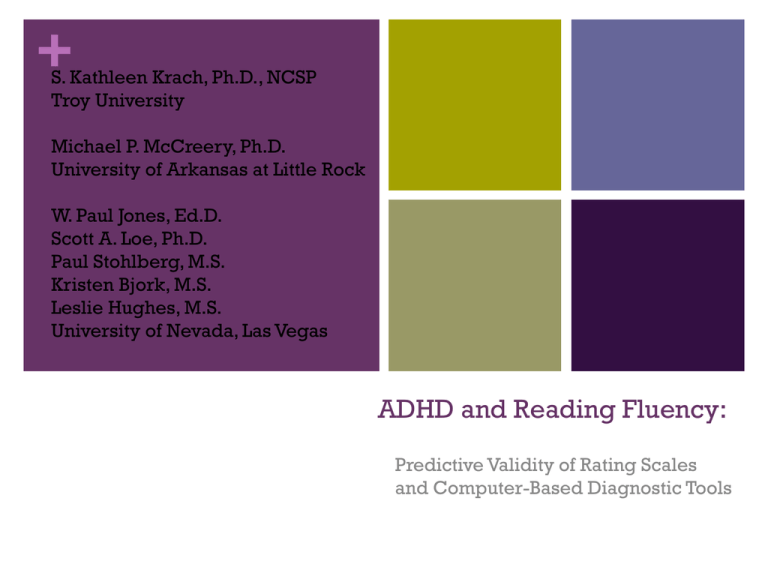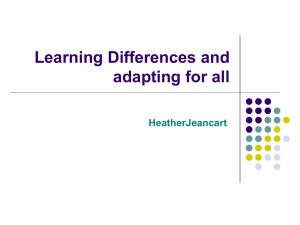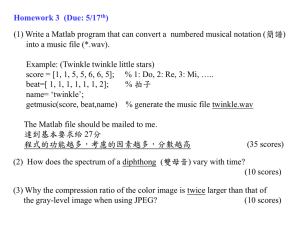
+
S. Kathleen Krach, Ph.D., NCSP
Troy University
Michael P. McCreery, Ph.D.
University of Arkansas at Little Rock
W. Paul Jones, Ed.D.
Scott A. Loe, Ph.D.
Paul Stohlberg, M.S.
Kristen Bjork, M.S.
Leslie Hughes, M.S.
University of Nevada, Las Vegas
ADHD and Reading Fluency:
Predictive Validity of Rating Scales
and Computer-Based Diagnostic Tools
+
Review of Literature
+
Attention Deficit Hyperactivity
Disorder (ADHD): DSM-IV
Primary Symptoms
Inattention: poor sustained
attention, disorganization,
forgetfulness, and difficulty
listening and following
directions.
Hyperactivity: squirming,
fidgeting, getting out of seat,
inappropriately loud volume.
Impulsivity: difficulty taking
turns, interrupting others, and
not waiting to provide an answer
to a question (blurts out).
Subtypes
ADHD: Predominantly
Inattentive
ADHD: Predominantly
Hyperactive-Impulsive
ADHD: Combined
+
ADHD: The Great Debate
The International Consensus on ADHD
Barkley (and 85 others) 2002
Timimi (and 33 others) 2004
ADHD exists.
Symptoms of ADHD may
actually be some other
condition or a systems issue
Studies linking to neurological
impairments are conclusive.
Studies linking to neurological
impairments are inconclusive.
Studies linking to genetics are
conclusive.
Studies linking to genetics are
inconclusive.
+
Assessment Tools:
Rating Scales
The primary method used in diagnosing ADHD is the use of
rating scales.
Rating scale publishers indicate strong psychometrics
Rating scales have issues with
Inconsistency across cultural groups
Inconsistency across gender
Halo effects
(Domínguez de Ramírez & Shapiro, 2005; Hartung, et al., 2006; Jackson & King, 2004; Mann, et al,
1992; Pellegrini, 2011; Sciutto and Eisneberg, 2007)
+
Assessment Tools: (CPT)
Continuous Performance Test
CPTs often described as
measures of attention and
impulsivity
Factors other than those
intended may affect CPT scores.
Internal: client’s personality,
drugs, and motivation.
External: white noise,
presence of an examiner, and
time of day.
Excellent job of identifying
those with ADHD; however,
tends to over diagnose those
without ADHD.
(Corkum & Siegel,1993; Schatz, 2001)
O
Y
+
Symptoms of ADHD are linked to
Lower levels of academic
performance (Marshall, Hynd,
Handwerk, & Hall, 1997)
Often experience a comorbid
diagnosis of learning
disability (Mayes, Calhoun, &
Crowell, 2000).
+
LaBerge & Samuels:
Automaticity Theory
Theory proposes a direct link
between reading fluency and
attention.
As readers became more
adept, they focus less attention
on the specific
subcomponents needed to
process written language.
With increased ability comes a
speed and ability to shift focus
from basic word reading to
reading comprehension.
+
Reading Fluency: Subtypes
Accuracy and Speed
A reader does not take the
time to process the entire
word or sentence before
determining it’s meaning.
Accuracy by speed: How many
words can you read (and
understand) within a set
period of time.
Impulsive readers will read
the first phoneme and
examine the length of the
word.
Assessed by scoring correct
items read in a timed situation.
Example: “Cat” becomes
“Car” but not “carpenter.”
Assessed by examining errors
made in reading.
Accuracy: How well can you
read (words correct).
Reading Speed: How quickly
can you read?
Reading Impulsivity
+
Research Questions
Are ADHD rating scale scores an accurate predictor of
reading fluency and/or reading impulsivity scores?
Are CPT scores an accurate predictor of reading fluency
and/or reading impulsivity scores?
Do rating scales scores and CPT scores provide shared
information useful in predicting reading fluency and/or
reading impulsivity scores?
+
Methods
+
Participants
91 undergraduate student
volunteers
General population from
College of Education
Sex
17% Male
74% Female
Ages 18 – 45 (mean = 23 years,
SD = 5 years)
Race / Ethnicity
4.4% Asian
9.9% African American
2.2% Native Hawaiian or
Pacific Islander
67% White Non Hispanic
5.5% Hispanic
11.0% Other
+
Conners Adult ADHD Rating
Scales (CAARS)
Fake Sample Items
Other people say that I am loud.
I enjoy activities that require focus.
I have trouble staying organized.
I interrupt when others are talking.
Scores Obtained
Inattention/ Memory Problems
Impulsivity/ Emotional Lability
Hyperactivity/ Restlessness
Problems with Self-Concept
ADHD Index (Composite)
Never
Sometimes
Often
Always
+
WJ-III: Achievement Reading
Fluency
Fake sample items (timed)
Dogs moo at passing cars.
Yes
No
Businessmen often wear suits.
Yes
No
Giraffes have long necks
Yes
No
Computers can have a keyboard and a mouse.
Yes
No
•Forms: A and B (for this study)
•A = group
•B = individual
•Scores:
•Individual standard scores(# correct - # incorrect = raw score)
•Group standard scores (# correct - # incorrect = raw score)
•Difference scores (individual – group)
•Error scores (# of incorrect from A + # of incorrect from B)
+ Automated Neuropsychological Assessment
Matrices (ANAM): Procedural Reaction Time
Example of Items
2 & 3 are LOW numbers
(click left mouse for LOW)
4
4 & 5 are HIGH numbers
(click right mouse for HIGH)
Scores
PRT1: Basic Block
PRT:2 Intermittent Block
Accuracy: # correct
Efficiency: # correct per
minute
2
+
Statistics
+
Descriptive Statistics
Note. ANAM = Automated Neuropsychological Assessment Matrices. PRT1 = Procedural Reaction Time
Basic Block. PRT2 = Procedural Reaction Time - Time Uncertainty Block. Accuracy (ACC) = Percentage
Correct. Efficiency (EFF) = Correct Responses Per Minute. CAARS = Conners Adult ADHD Rating Scales.
Inatt = Inattention. Impul = Impulsivity. Hyper = Hyperactivity. Comp = Composite. WJ-III: ACH RF =
Woodcock Johnson Tests of Achievement, Third Edition Reading Fluency. Indiv = Individual. Diff =
Difference. * = p < .05. ** = p < .01
+
Correlation Statistics
Note. ANAM = Automated Neuropsychological Assessment Matrices. PRT1 = Procedural Reaction Time
Basic Block. PRT2 = Procedural Reaction Time - Time Uncertainty Block. Accuracy (ACC) = Percentage
Correct. Efficiency (EFF) = Correct Responses Per Minute. CAARS = Conners Adult ADHD Rating Scales.
Inatt = Inattention. Impul = Impulsivity. Hyper = Hyperactivity. Comp = Composite. WJ-III: ACH RF =
Woodcock Johnson Tests of Achievement, Third Edition Reading Fluency. Indiv = Individual. Diff =
Difference. * = p < .05. ** = p < .01
+
Regressions
Models 1 - 4
ANAM
Models 5 - 8
CAARS
ANAM
CAARS
Models 9 - 12
WJ-III:ACH
Reading
Fluency
WJ-III:ACH
Reading
Fluency
WJ-III:ACH
Reading
Fluency
+
Model 2: Regression Results
(12.45% of the Variance)
ANAM
PRT (All)
WJ-III:RF
Group
None others were statistically significant!
+
Sobel Regression Models
CAARS
ANAM
WJ-III:ACH
Reading
Fluency
+
Sobel Regressions
Although 64 separate Sobel regressions were run, not one
provided the statistical significance needed
to indicate the predicted mediating relationship.
+
Discussion
+
Research Questions
Are ADHD rating scale scores an accurate predictor of
reading fluency and/or reading impulsivity scores?
Are CPT scores an accurate predictor of reading fluency
and/or reading impulsivity scores?
Do rating scales scores and CPT scores provide shared
information useful in predicting reading fluency and/or
reading impulsivity scores?
+ Are ADHD rating scale scores an accurate predictor of reading
fluency and/or reading impulsivity scores?
Rational for Question:
Individuals with ADHD exhibit more academic problems
(Marshall, Hynd, Handwerk, & Hall, 1997).
Individuals with ADHD often experience a comorbid diagnosis of
learning disability (Mayes, Calhoun, & Crowell, 2000).
Finding:
There is NO significant relationship between any of the ADHD
rating scale scores and any of the reading fluency scores.
+ Are CPT scores an accurate predictor of reading fluency
and/or reading impulsivity scores?
CPT scores sometimes do predict scores on reading fluency.
Neither the inattention scores (as defined by group / individual
difference scores) nor the reading impulsivity scores (as defined
by the error scores) were predicted by any of the CPT scores
It appears that the CPT used in this study may be a measure of
something else other than ADHD symptoms.
General neurological functioning (Alloway, et al., 2009;
Preston, Fennell, & Bussing, 2005)
Intellectual skills (Jones, et. al, 2007)
Processing speed (Stolberg, Jones, Krach, & Loe, 2009)
+ Do rating scales scores and CPT scores provide shared
information useful in predicting reading scores?
No.
+
Rating Scale vs. CPT
At this time, rating scales are the clear frontrunner ADHD
diagnostic tool (Macmann, Barnet, & Lopez, 1993; Sattler &
Hoge, 2006; Sciutto &Eisenberg, 2007).
Rating scales have significant issues that should give any
good diagnostic specialist pause before using them as a sole
method of data collection for ADHD (Hartung, et al., 2006;
Jackson & King, 2004; Pellegrini, 2011; Rosenbaum & Valsiner,
2011).
Clearly we need a direct method to add to our toolkit.
+
Researcher vs. Practitioner
In the argument for whether the absence or presence of
neurological symptoms is a basis for explaining symptoms
associated with ADHD (Barkely, et al., 2002; Timimi, et al.,
2004), CPTs should be included as a data collection tool.
As a diagnostic tool, it may more useful to assess
neurological concerns linked to ADHD and less useful in
evaluating inattention, impulsivity, an hyperactivity directly
(Corkum & Siegel, 1993).








